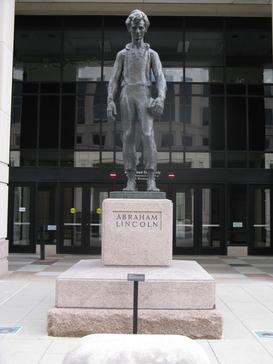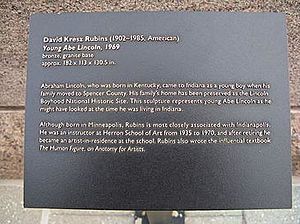Young Abe Lincoln facts for kids
Young Abe Lincoln is a large bronze sculpture. It was created in 1962 by an American artist named David K. Rubins. You can find it outside the government buildings near the Indiana Statehouse in Indianapolis, Indiana, USA.
This sculpture shows a young Abraham Lincoln. He spent most of his growing-up years in Indiana. This artwork helps us remember his time there.
Contents
What Does Young Abe Lincoln Look Like?
Young Abe Lincoln is a very big bronze sculpture. It shows Abraham Lincoln as a teenager. He looks a bit rough, like he's from the frontier.
He wears a simple shirt and pants. His pants are rolled up above his ankles. He is also barefoot, meaning he has no shoes on. In his left hand, he holds a book. His index finger is holding his place in the book.
The sculpture stands outside the Indiana Government Center in Indianapolis. This area is right next to the Indiana Statehouse. The statue itself is about 108 inches (9 feet) tall. It sits on a red granite base. This base is about 74 inches tall. The whole sculpture weighs over 1,500 pounds.
You can see the artist's signature, D.K. Rubins, on the back of the sculpture. It also shows the year it was made, 1962.
How Was the Sculpture Made?
Creating Young Abe Lincoln was a long process. First, the artist made a smaller model out of plaster. This model was about 46 inches tall.
Then, they used a special machine to make a rough, hollow wooden frame. This frame was the full size of the final sculpture. Next, the artist covered this frame with a special kind of clay. He then added all the small details by hand.
After the clay model was perfect, a plaster mold was made over it. Once this mold dried, it was removed. This created a plaster copy of the clay model.
Finally, the bronze sculpture was made using a method called lost-wax casting. This is a very old and detailed way to make metal sculptures. It took over five months to finish the bronze statue.
What the Artist Wanted to Show
David K. Rubins, the artist, explained his ideas for the sculpture. He wanted to show Lincoln's strong energy and physical strength. He also wanted to show how Lincoln's character grew, like a tree with deep roots. This growth happened during his years in Indiana.
Rubins tried to show Lincoln's kind, frontier spirit. He also wanted to show his tall, bony frame. The simple base and thoughtful head show Lincoln's smart mind. They also hint at the sad parts of his life.
The artist gave Lincoln boyish and funny hair. He didn't try to make an exact picture of Lincoln at age 21. Instead, he mixed how Lincoln looked as a young man with how he looked later in life. This is because most pictures of Lincoln are from when he was older.
Rubins felt that the book was very important. It shows Lincoln's love for learning. He thought the axe, often linked with Lincoln, was less important than the book.
The sculpture was placed among trees. Rubins felt this was right because Lincoln spent his Indiana years in forests.
How the Sculpture Came to Be
This sculpture was made after an art competition. The competition was held in 1959. Artists were asked to create artwork for the Indiana State Office Building. They could choose their own subject, size, and materials.
Here were some ideas for the artists:
- Lincoln was a good theme. He spent much of his youth in Indiana and visited later.
- The Indiana State Seal could be used somewhere.
- A possible spot was near the reflecting pool.
- The artwork should look modern and fit the buildings.
Artists had to send in a small model or sketch of their work. They also had to write a letter explaining their ideas. Many artists were invited to join the competition.
Who Judged the Art?
A group of experts judged the artworks. This group included museum directors and art department heads from universities. They chose the best pieces. The chosen artists then got some money to make a larger model.
David K. Rubins first sent a 12-inch model. Then he made a 46-inch plaster model. This larger model was chosen as the winner! Rubins received money and two years to create the full-size bronze statue.
On September 26, 1963, Rubins' Young Abe Lincoln was officially shown to the public. Everyone was very excited about it.
Where Has the Sculpture Been?
There were many ideas for where to put the statue. Some thought it should be in the Orchard Area or on a terrace.
The sculpture was first placed about half a block east of where it is now. It faced Senate Avenue. In 1992, it was moved to its current spot. Now it is outside the Government Center, near West Street and Robert D. Orr Avenue.
About the Artist: David K. Rubins
David K. Rubins was born in Minneapolis. He studied art in New York City and Paris, France. He worked with a famous sculptor named James Earle Fraser for seven years. Fraser designed the Buffalo nickel.
Rubins won many important awards for his sculptures. These included the Paris Prize in Sculpture and the Prix de Rome.
In 1935, Rubins moved to Indianapolis, Indiana. He became a teacher at the John Herron Art Institute. He taught there until 1967. He was even in charge of the sculpture department for many years. In 1954, he wrote a book called The Human Figure, an Anatomy for Artists.
Rubins also created other artworks in Indianapolis. These include a statue of Governor Henry Schricker and the Eli Lilly monument.
His art has been shown in many famous museums. These include the Minneapolis Institute of Art and the Metropolitan Museum of Art in New York.
For Young Abe Lincoln, Rubins read many books about Lincoln's life. He also looked at other famous Lincoln sculptures. These included the large statue at the Lincoln Memorial in Washington, D.C., and the one on Mount Rushmore.



